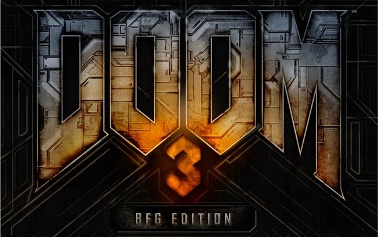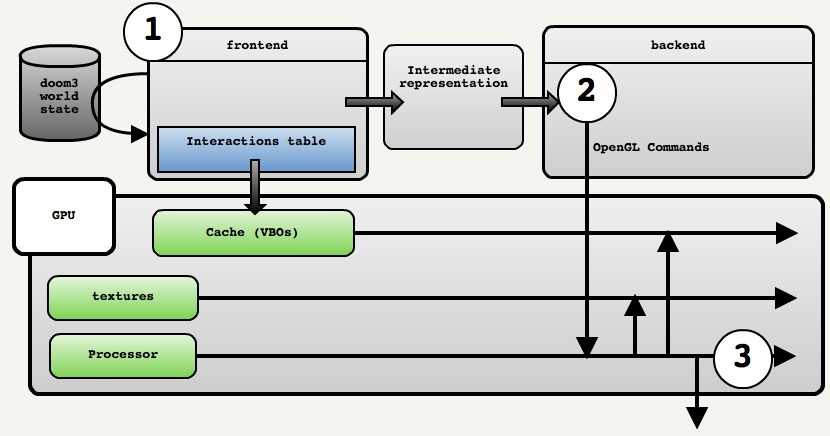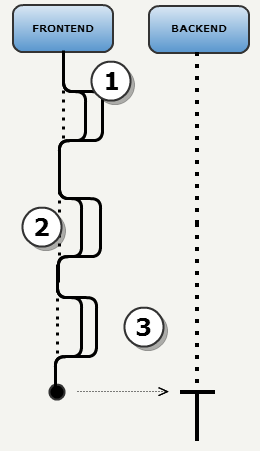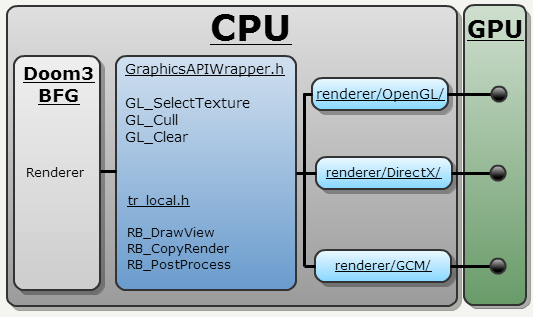Doom3 BFG Source Code Review: Renderer (Part 3 of 4) >>
 Doom 3 BFG renderer is at its core still the same: Search for interactions (lights crossing the view frustum)
and perform an additive blending pass for each interactions. A process that I described in my first series of articles about Doom3 engine.
Doom 3 BFG renderer is at its core still the same: Search for interactions (lights crossing the view frustum)
and perform an additive blending pass for each interactions. A process that I described in my first series of articles about Doom3 engine.
The key innovation is that the once mono-threaded renderer is now "heavily" multi-threaded with up to four threads running concurrently.
Architecture
The renderer is still divided in two parts: Frontend (1) and Backend (2). The Frontend does the "smart" work of determining what should be drawn while the backend spends most of its
time executing those commands and waiting for the GPU to execute them (that and also waiting for a vsync !).

Threading model
 There are two important novelties:
There are two important novelties:
The Job System is described in the previous article. What was interesting was to look how Jobs are parallelized without mutexes:
1. Find lights (R_AddLights): The idea is to perform a "Build, Mark and Sweep" on a linked list:
2. Find Models (R_AddModels) : Each Job works on a specific model. When all workers are done, vertice to draw results are aggregated by a single thread.
3. Build Dynamic Shadow Volumes (R_AddModels): Same idea: Each worker stores shadow volumes results in the model it is working on. A single thread aggregates the results later.
One Path
 The previous renderer featured many rendering path: One for
each Nvidia and ATI GPUs. The implementation was not very elegant since it
relied on switch cases.
The previous renderer featured many rendering path: One for
each Nvidia and ATI GPUs. The implementation was not very elegant since it
relied on switch cases.
The new renderer uses an
abstraction layer based on OpenGL for method names. Under the hood either :
- OpenGL (PC)
- DirectX (Xbox360)
- GCM (PS3)
can be used for implementation. The project linker
decides which implementation to use.
Shaders
Doom III used ARB assembly shaders that looked like this:
!!ARBfp1.0
TEMP color;
MUL color, fragment.texcoord[0].y, 2.0;
ADD color, 1.0, -color;
ABS color, color;
ADD result.color, 1.0, -color;
MOV result.color.a, 1.0;
END
Doom III BFG uses OpenGL GLSL 1.50 shaders:
#version 150
#define PC
void main() {
vec4 color = ( tex2D ( samp0 , vofi_TexCoord0 ) * gl_Color ) + vofi_TexCoord1 ;
gl_FragColor . xyz = color. xyz * color. w ;
gl_FragColor . w = color. w ;
}
Trivia : The renderer uses OpenGL 3.2 Compatibility Profile since many OpenGL methods have been deprecated since 2004 but the engine uses
recent shaders. This is one of the reason Doom III BFG has not been ported to MacOS X: Even the latest Mountain Lion only offers OpenGL 3.2 Core profile.
Unused
The renderer features other cool things are are barely used:
- An HLSL to GLSL converter (
ConvertCG2GLSL): Used nowhere :( ! - The fast DXT texture compressor (
YCoCg-DXT5), one of the keystone of idTech5 virtual texturing mentioned in Beyond Programing Shaders 2009 talk: Used for a few tiny textures only.
Rendering Targets
Considering all the post-rendering screenspace processing (Fog and Occulus Rift VR barrel wrapping), I was expecting to see FBOs and framebuffer rendering Targets bindings all over the place.
Surprisingly, when such effects are needed the process is to copy the GL_BACK buffer to a texture via glCopyTexImage2D and draw it
again (with the proper shader) in the GL_BACK buffer.
Wait, there is more...
A reader "Ben" mentioned a few other collections of performance shifts that I did not have time to review:
- GPU skinning.
- Using VertexCache as massive global double buffers instead of each RenderModel handling their own VBO.
- Using glMap instead of glBuffer for VBO (which originally causes major stalls, limiting enemy counts).